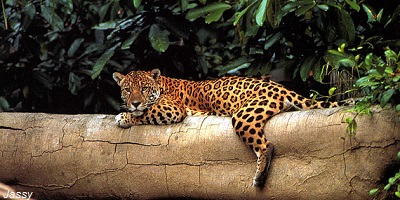
The Manu National Park, located in southeastern Peru (between the regions of Cusco and Madre de Dios) is one of the largest tropical parks in South America. The park extends from the mountains to the jungle. It covers two million hectares (4.5 million acres), and the territory is rich in flora and fauna with a wide variety of habitats, including the high Andes, rain forests, and rain forests of plains.
In 1977, the Manu National Park was designated as a World Biological Reserve, home to otters, caimans, jaguars, approximately 13 species of primates and about 1000 species of birds, as well as 10% of the vascular plant species in the world, including several species of figs and palms, and innumerable species of medicinal plants, which are being cataloged by scientists. A single hectare of Manu forest can have up to 220 species of trees, while a hectare of temperate forest in Europe or North America can be up to twenty species of trees. The Manu National Park can be considered the park with the greatest biological diversity and the most protected on the planet.
Departure from the city of Cusco very early in the morning in one of our specially equipped vehicles for the route. We will cross interesting inter-Andean valleys and picturesque rural communities visiting the Pre-Inca Tombs "Chullpas" of Ninamarca. At noon we will pass through Paucartambo, a typical colonial town of great importance at that time and that still retains its colonial style, we will have our lunch on the route and we will continue the journey through the Cloud Forest, the Bears Eyeglasses area, Gallito de Rocks, orchids, bromeliads, ferns, etc., until we reach our Orquídeas de San Pedro hostel where we will spend our first night.
In the morning, we will go in search of the Cock of the Rocks, national bird of Peru with a striking plumage of red and orange colors, to appreciate its courtship dance. After breakfast, we start the journey to the town of Pilcopata and then to the port of Atalaya on the banks of the Alto Madre de Dios River, where we will take our motor boat to descend the river. During this trip, we will observe the great variety of bird species that exist in the area: grazas, vultures, cormorants, etc; until we reach the Private Reserve "Erika" where we will spend our second night. We will walk through trails through the jungle and receive an explanation of the wildlife that surrounds us.
After breakfast, we will take a morning walk with our guide, where we will enjoy and learn about the wildlife that surrounds us. Then, we will board our boat, cross the river and walk about 30 minutes through a path where we will observe diversity of flowers such as sensitive plants, heliconias, fruit trees, among others; until we reach the Laguna de Machuwasi, where we row in canoes and observe the different species of birds in the area. At night, we will walk around the lodge to observe amphibians and insects.
Early in the morning, we will board our motor boat bound for the Collpa, a wall of the river where diversity of parrots, parrots and possibly even macaws come to extract and lick the clay from the wall every morning, this because of allegedly Clay contains minerals that are necessary in your diet. Once the activity is over, we will return to the lodge to look for some things and return by boat to the Port of Atalaya, where the transport that will take us to Cusco will be waiting for us. We will have lunch on the route and we will be arriving in Cusco at night.
Prices for person in US Dollars